Chapter 27: Psychosocial Development in Middle Adulthood
Chapter 27 Learning Objectives
- Explain the controversy surrounding the concept of a midlife crisis
- Explain the sources of stress confronting adults in midlife and the strategies to cope
- Summarize Erikson’s seventh psychosocial task of generativity vs. stagnation
- Describe the relationships middle-aged adults have with their children, parents, and other family members
- Describe singlehood, marriage, divorce, and remarriage at midlife
- Describe the contemporary roles of grandparents
- Describe friendships at midlife
- Explain how women are uniquely affected at midlife
- Describe friendships at midlife
- Explain how women are uniquely affected at midlife
- Explain the role of religion at midlife
There are many socioemotional changes that occur in how middle-aged adults perceive themselves. While people in their early 20s may emphasize how old they are to gain respect or to be viewed as experienced, by the time people reach their 40s they tend to emphasize how young they are. For instance, a few 40-year-olds cut each other down for being so young stating: “You’re only 43? I’m 48!” A previous focus on the future gives way to an emphasis on the present. Neugarten (1968) notes that in midlife, people no longer think of their lives in terms of how long they have lived. Rather, life is thought of in terms of how many years are left.
Midlife Crisis?
In 1978 Daniel Levinson published a book entitled The Seasons of a Man’s Life in which he presented a theory of development in adulthood. Levinson’s work was based on in-depth interviews with 40 men between the ages of 35-45. Levinson (1978) indicated that adults go through stages and have an image of the future that motivates them. This image is called “the dream” and for the men interviewed, it was a dream of how their career paths would progress and where they would be at midlife. According to Levinson the midlife transition (40-45) was a time of reevaluating previous commitments; making dramatic changes if necessary; giving expression to previously ignored talents or aspirations, and feeling more of a sense of urgency about life and its meaning. By the time the men entered middle adulthood (45-50), they believed they committed to the new choices made and placed one’s energies into these commitments.
Levinson believed that a midlife crisis was a normal part of development as the person is more aware of how much time has gone by and how much time is left. The future focus of early adulthood gives way to an emphasis on the present in midlife, and the men interviewed had difficulty reconciling the “dream” they held about the future with the reality they experienced. Consequently, they felt impatient and were no longer willing to postpone the things they had always wanted to do. Although Levinson believed his research demonstrated the existence of a midlife crisis, his study has been criticized for his research methods, including small sample size, similar ages, and concerns about a cohort effect. In fact, other research does not support his theory of the midlife crisis.
Vaillant (2012) believed that it was the cross-sectional design of Levinson’s study that led to the erroneous conclusion of an inevitable midlife crisis. Instead, he believed that longitudinal studies of an individual’s entire life were needed to determine the factors associated with optimum health and potential. Vaillant was one of the main researchers in the 75-year-old Harvard Study of Adult Development, and he considered a midlife crisis to be a rare occurrence among the participants (Vaillant, 1977). Additional findings of this longitudinal study will be discussed in the next chapter in late adulthood.
Most research suggests that most people in the United States today do not experience a midlife crisis. Results of a 10-year study conducted by the MacArthur Foundation Research Network on Successful Midlife Development, based on telephone interviews with over 3,000 midlife adults, suggest that the years between 40 and 60 are ones marked by a sense of well-being. Only 23% of the participants reported experiencing a midlife crisis. The crisis tended to occur among the highly educated and was triggered by a major life event rather than out of fear of aging (Research Network on Successful Midlife Development, 2007).
Stress

We all know that stress plays a major role in our mental and physical health, but what exactly is stress? The term stress is defined as a pattern of physical and psychological responses in an organism after it perceives a threatening event that disturbs its homeostasis and taxes its abilities to cope with the event (Hooker & Pressman, 2016). Stress was originally derived from the field of mechanics where it is used to describe materials under pressure. The word was first used in a psychological manner by researcher Hans Selye, who was examining the effect of an ovarian hormone that he thought caused sickness in a sample of rats. Surprisingly, he noticed that almost any injected hormone produced this same sickness. He smartly realized that it was not the hormone under investigation that was causing these problems, but instead, the aversive experience of being handled and injected by researchers led to high physiological arousal, and eventually to health problems like ulcers. Selye (1946) coined the term stressor to label a stimulus that had this effect on the body (that is, causing stress). He developed a model of the stress response called the General Adaptation Syndrome, which is a three-phase model of stress, which includes a mobilization of physiological resources phase, a coping phase, and an exhaustion phase (i.e., when an organism fails to cope with the stress adequately and depletes its resources). Figure 8.25 illustrates the General Adaptation Syndrome.
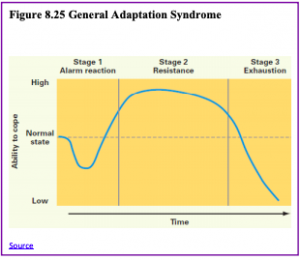
Psychologists have studied stress in a myriad of ways, and it is not just a major life stressor (e.g., a family death, a natural disaster) that increases the likelihood of getting sick. Stress can result from negative events, chronically difficult situations, a biological fight-or-flight response, and as clinical illness, such as post-traumatic stress disorder (PTSD). Even small daily hassles, like getting stuck in traffic or fighting with your friend, can raise your blood pressure, alter your stress hormones, and even suppress your immune system function (DeLongis, Folkman, & Lazarus, 1988; Twisk, Snel, Kemper, & van Machelen, 1999). Stress continues to be one of the most important and well-studied psychological correlates of illness because excessive stress causes potentially damaging wear and tear on the body and can influence almost any disease process.
Dispositions and Stress: Negative dispositions and personality traits have been strongly tied to an array of health risks. One of the earliest negative trait-to-health connections was discovered in the 1950s by two cardiologists. They made the interesting discovery that there were common behavioral and psychological patterns among their heart patients that were not present in other patient samples. This pattern included being competitive, impatient, hostile, and time urgent. They labeled it Type A Behavior. Importantly, it was found to be associated with double the risk of heart disease as compared with Type B Behavior (absence of Type A behaviors) (Friedman & Rosenman, 1959). Since the 1950s, researchers have discovered that it is the hostility and competitiveness components of Type A that are especially harmful to heart health (Iribarren et al., 2000; Matthews, Glass, Rosenman, & Bortner, 1977; Miller, Smith, Turner, Guijarro, & Hallet, 1996). Hostile individuals are quick to get upset, and this angry arousal can damage the arteries of the heart. In addition, given their negative personality style, hostile people often lack a heath-protective supportive social network.
Social Relationships and Stress: Research has shown that the impact of social isolation on our risk for disease and death is similar in magnitude to the risk associated with smoking regularly (Holt-Lunstad, Smith, & Layton, 2010; House, Landis, & Umberson, 1988). In fact, the importance of social relationships for our health is so significant that some scientists believe our body has developed a physiological system that encourages us to seek out our relationships, especially in times of stress (Taylor et al., 2000). Social integration is the concept used to describe the number of social roles that you have (Cohen & Willis, 1985). For example, you might be a daughter, a basketball team member, a Humane Society volunteer, a coworker, and a student. Maintaining these different roles can improve your health via encouragement from those around you to maintain a healthy lifestyle. Those in your social network might also provide you with social support (e.g., when you are under stress). This support might include emotional help (e.g., a hug when you need it), tangible help (e.g., lending you money), or advice. By helping to improve health behaviors and reduce stress, social relationships can have a powerful, protective impact on health, and in some cases, might even help people with serious illnesses stay alive longer (Spiegel, Kraemer, Bloom, & Gottheil, 1989).
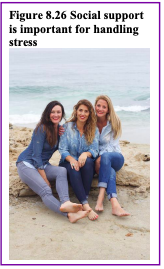
Caregiving and Stress: A disabled child, spouse, parent, or other family member is part of the lives of some midlife adults. According to the National Alliance for Caregiving (2015), 40 million Americans provide unpaid caregiving. The typical caregiver is a 49-year-old female currently caring for a 69-year-old female who needs care because of a long-term physical condition. Looking more closely at the age of the recipient of caregiving, the typical caregiver for those 18-49 years of age is a female (61%) caring mostly for her own child (32%) followed by a spouse or partner (17%). When looking at older recipients (50+) who receive care, the typical caregiver is female (60%) caring for a parent (47%) or spouse (10%).
Caregiving places enormous stress on the caregiver. Caregiving for a young or adult child with special needs was associated with poorer global health and more physical symptoms among both fathers and mothers (Seltzer, Floyd, Song, Greenberg, & Hong, 2011). Marital relationships are also a factor in how caring affects stress and chronic conditions. Fathers who were caregivers identified more chronic health conditions than non-caregiving fathers, regardless of marital quality. In contrast, caregiving mothers reported higher levels of chronic conditions when they reported a high level of marital strain (Kang & Marks, 2014). Age can also make a difference in how one is affected by the stress of caring for a child with special needs. Using data from the Study of Midlife in the United States, Ha, Hong, Seltzer, and Greenberg (2008) found that older parents were significantly less likely to experience the negative effects of having a disabled child than younger parents. They concluded that an age-related weakening of the stress occurred over time. This follows with the greater emotional stability noted at midlife.
Currently, 25% of adult children, mainly baby boomers, provide personal or financial care to a parent (Metlife, 2011). Daughters are more likely to provide basic care and sons are more likely to provide financial assistance. Adult children 50+ who work and provide care to a parent are more likely to have fair or poor health when compared to those who do not provide care. Some adult children choose to leave the workforce, however, the cost of leaving the workforce early to care for a parent is high. For females, lost wages and social security benefits equal $324,044, while for men it equals $283,716 (Metlife, 2011). This loss can jeopardize the adult child’s financial future. Consequently, there is a need for greater workplace flexibility for working caregivers.
Spousal Care: Certainly, caring for a disabled spouse would be a difficult experience that could negatively affect one’s health. However, research indicates that there can be a positive health effect on caring for a disabled spouse. Beach, Schulz, Yee, and Jackson (2000) evaluated health-related outcomes in four groups: Spouses with no caregiving needed (Group 1), living with a disabled spouse but not providing care (Group 2), living with a disabled spouse and providing care (Group 3), and helping a disabled spouse while reporting caregiver strain, including elevated levels of emotional and physical stress (Group 4). Not surprisingly, the participants in Group 4 were the least healthy and identified poorer perceived health, an increase in health-risk behaviors, and an increase in anxiety and depression symptoms. However, those in Group 3 who provided care for a spouse, but did not identify caregiver strain, actually identified decreased levels of anxiety and depression compared to Group 2 and were actually similar to those in Group 1. It appears that greater caregiving involvement was related to better mental health as long as the caregiving spouse did not feel the strain. The beneficial effects of helping identified by the participants were consistent with previous research (Krause, Herzog, & Baker, 1992; Schulz et al., 1997).
When caring for a disabled spouse, gender differences have also been identified. Female caregivers of a spouse with dementia experienced more burden, had poorer mental and physical health, exhibited increased depressive symptomatology, took part in fewer health-promoting activities, and received fewer hours of help than male caregivers (Gibbons et al., 2014). This study was consistent with previous research findings that women experience more caregiving burden than men, despite similar caregiving situations (Torti, Gwyther, Reed, Friedman, & Schulman, 2004; Yeager, Hyer, Hobbs, & Coyne, 2010). Explanations for why women do not use more external support, which may alleviate some of the burdens, include women’s expectations that they should assume caregiving roles (Torti et al, 2004) and their concerns with the opinions of others (Arai, Sugiura, Miura, Washio, & Kudo, 2000). Also contributing to women’s poorer caregiving outcomes is that disabled males are more aggressive than females, especially males with dementia who display more physical and sexual aggression toward their caregivers (Eastley & Wilcock, 1997; Zuidema, de Jonghe, Verhey, & Koopmans, 2009). Female caregivers are certainly at risk for negative consequences of caregiving, and greater support needs to be available to them.
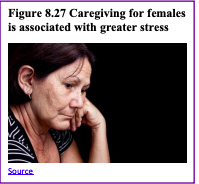
Stress Management: On a scale from 1 to 10, those Americans aged 39-52 rated their stress at 5.3, and those aged 53-71 rated their stress at 3.9 (American Psychological Association, 2017). The most common sources of stress included the future of our nation, money, work, current political climate, and violence and crime. Given that these sources of our stress are often difficult to change, a number of interventions have been designed to help reduce the aversive responses to duress, especially related to health. For example, relaxation activities and forms of meditation are techniques that allow individuals to reduce their stress via breathing exercises, muscle relaxation, and mental imagery. Physiological arousal from stress can also be reduced via biofeedback, a technique where the individual is shown bodily information that is not normally available to them (e.g., heart rate), and then taught strategies to alter this signal. This type of intervention has even shown promise in reducing heart and hypertension risk, as well as other serious conditions (Moravec, 2008; Patel, Marmot, & Terry, 1981). Reducing stress does not have to be complicated. For example, exercise is a great stress reduction activity (Salmon, 2001) that has a myriad of health benefits.
Coping Strategies: Coping is often classified into two categories: Problem-focused coping or emotion-focused coping (Carver, Scheier, & Weintraub, 1989). Problem-focused coping is thought of as actively addressing the event that is causing stress in an effort to solve the issue at hand. For example, say you have an important exam coming up next week. A problem-focused strategy might be to spend additional time over the weekend studying to make sure you understand all of the material. Emotion-focused coping, on the other hand, regulates the emotions that come with stress. In the above examination example, this might mean watching a funny movie to take your mind off the anxiety you are feeling. In the short term, emotion-focused coping might reduce feelings of stress, but problem-focused coping seems to have the greatest impact on mental wellness (Billings & Moos, 1981; Herman-Stabl, Stemmler, & Petersen, 1995). That being said, when events are uncontrollable (e.g., the death of a loved one), emotion-focused coping directed at managing your feelings, at first, might be the better strategy. Therefore, it is always important to consider the match of the stressor to the coping strategy when evaluating its plausible benefits.

Erikson: Generativity vs Stagnation
According to Erikson (1950, 1982) generativity encompasses procreativity, productivity, and creativity. This stage includes the generation of new beings, new products, and new ideas, as well as self-generation concerned with further identity development. Erikson believed that the stage of generativity, during which one established a family and career, was the longest of all the stages. Individuals at midlife are primarily concerned with leaving a positive legacy of themselves, and parenthood is the primary generative type. Erikson understood that work and family relationships may be in conflict due to the obligations and responsibilities of each, but he believed it was overall a positive developmental time. In addition to being parents and working, Erikson also described individuals being involved in the community during this stage. A sense of stagnation occurs when one is not active in generative matters, however, stagnation can motive a person to redirect energies into more meaningful activities.
Erikson identified “virtues” for each of his eight stages, and the virtue emerging when one achieves generativity is “Care”. Erikson believed that those in middle adulthood should “take care of the persons, the products, and the ideas one has learned to care for” (Erikson, 1982, p. 67). Further, Erikson believed that the strengths gained from the six earlier stages are essential for the generational task of cultivating strength in the next generation. Erikson further argued that generativity occurred best after the individual had resolved issues of identity and intimacy (Peterson & Duncan, 2007).
Research has demonstrated that generative adults possess many positive characteristics, including good cultural knowledge and healthy adaptation to the world (Peterson & Duncan, 2007). Using the Big 5 personality traits, generative women and men scored high on conscientiousness, extraversion, agreeableness, openness to experience, and low on neuroticism (de St. Aubin & McAdams, 1995; Peterson, Smirles, & Wentworth, 1997). Additionally, women scoring high in generativity at age 52, were rated high in positive personality characteristics, satisfaction with marriage and motherhood, and successful aging at age 62 (Peterson & Duncan, 2007). Similarly, men rated higher in generativity at midlife were associated with stronger global cognitive functioning (e.g., memory, attention, calculation), stronger executive functioning (e.g., response inhibition, abstract thinking, cognitive flexibility), and lower levels of depression in late adulthood (Malone, Liu, Vaillant, Rentz, & Waldinger, 2016).

Erikson (1982) indicated that at the end of this demanding stage, individuals may withdraw as generativity is no longer expected in late adulthood. This releases elders from the task of caretaking or working. However, not feeling needed or challenged may result in stagnation, and consequently one should not fully withdraw from generative tasks as they enter Erikson’s last stage in late adulthood.
Midlife Relationships
The sandwich generation refers to adults who have at least one parent age 65 or older and are either raising their own children or providing support for their grown children. According to a recent Pew Research survey, 47% of middle-aged adults are part of this sandwich generation (Parker & Patten, 2013). In addition, 15% of middle-aged adults are providing financial support to an older parent while raising or supporting their own children (see Figure 8.30). According to the same survey, almost half (48%) of middle-aged adults, have supported their adult children in the past year, and 27% are the primary source of support for their grown children.
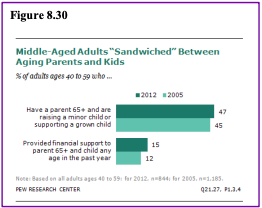
Seventy-one percent of the sandwich generation is age 40-59, 19% were younger than 40, and 10% were 60 or older. Hispanics are more likely to find themselves supporting two generations; 31% have parents 65 or older and a dependent child, compared with 24% of whites and 21% of blacks (Parker & Patten, 2013). Women are more likely to take on the role of care provider for older parents in the U.S. and Germany (Pew Research, 2015). About 20% of women say they have helped with personal care, such as getting dressed or bathing, of aging parents in the past year, compared with 8% of men in the U.S. and 4% in Germany. In contrast, in Italy men are just as likely (25%) as women (26%) to have provided personal care.
The Pew survey found that almost 33% of the sandwich-generation adults were more likely to say they always feel rushed, while only 23% of other adults said this. However, the survey suggests that those who were supporting both parents and children reported being just as happy as those middle-aged adults who did not find themselves in the sandwich generation (Parker & Patten, 2013). Adults who are supporting both parents and children did report greater financial strain (see Figure 8.31). Only 28% reported that they were living comfortably versus 41% of those who were not also supporting their parents. Almost 33% were just making ends meet, compared with 17% of those who did not have the additional financial burden of aging parents.
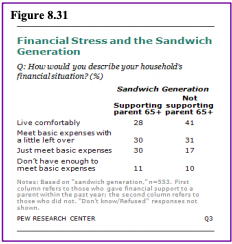
Kinkeeping: At midlife adults may find themselves as kinkeeper. In all families, there is a person or persons who keep the family connected and who promote solidarity and continuity in the family (Brown & DeRycke, 2010). Who in your own family do you count on to organize family gatherings? Who knows the history of your family? Who do people turn to in your family for advice and support? Who works to strengthen the bonds between members of your family?
These are your family’s kin keepers, and they are usually women (Leach & Braithwaite, 1996; Brown & DeRycke, 2010). Leach and Braithwaite found that 86% of their respondents named a woman as their family’s kinkeeper, and Brown and DeRycke found that mothers, maternal grandmothers, and paternal grandmothers were more likely to be a family’s kinkeeper than were fathers, young adult children, and grandfathers combined. Brown and DeRycke also found that among young adults, women were more likely to be a kinkeeper than were young adult men.
Kinkeeping can be a source of distress when it interferes with other obligations (Gerstel & Gallagher, 1993). Gerstel and Gallagher found that on average, kin keepers provide almost a full week of work each month to kinkeeping (almost 34 hours). They also found that the more activities the kinkeeper took on, and the more kin they helped the more stress and higher the levels of depression a kinkeeper experienced. However, unlike other studies on kinkeeping, Gerstel and Gallagher also included a number of activities that would be considered more “caregiving,” such as providing transportation, making repairs, providing meals, etc. in addition to the usual activities of kinkeeping.
Empty nest: The empty nest or post-parental period refers to the time period when children are grown up and have left home (Dennerstein, Dudley & Guthrie, 2002). For most parents, this occurs during midlife. This time is recognized as a “normative event” as parents are aware that their children will become adults and eventually leave home (Mitchell & Lovegreen, 2009). The empty nest creates complex emotions, both positive and negative, for many parents. Some theorists suggest this is a time of role loss for parents, others suggest it is one of role strain relief (Bouchard, 2013).
The role loss hypothesis predicts that when people lose an important role in their life they experience a decrease in emotional well-being. It is from this perspective that the concept of the empty nest syndrome emerged, which refers to great emotional distress experienced by parents, typically mothers, after children have left home. The empty nest syndrome is linked to the absence of alternative roles for the parent in which they could establish their identity (Borland, 1982). In Bouchard’s (2013) review of the research, she found that few parents reported loneliness or a big sense of loss once all their children had left home.
In contrast, the role stress relief hypothesis suggests that the empty nest period should lead to more positive changes for parents, as the responsibility of raising children has been lifted. The role strain relief hypothesis was supported by many studies in Bouchard’s (2013) review. A consistent finding throughout the research literature is that raising children has a negative impact on the quality of marital relationships (Ahlborg, Misvaer, & Möller, 2009; Bouchard, 2013). Most studies have reported that marital satisfaction often increases during the launching phase of the empty nest period and that this satisfaction endures long after the last child has left home (Gorchoff, John, & Helson, 2008).
However, most of the research on the post-parental period has been with American parents. A number of studies in China suggest that empty-nesters, especially in more rural areas of China, report greater loneliness and depression than their counterparts with children still at home (Wu et al., 2010). Family support for the elderly by their children is a cherished Chinese tradition (Wong & Leung, 2012). With children moving from the rural communities to the larger cities for education and employment this may explain the more pessimistic reaction of Chinese parents than in American samples. The loss of an adult child in a rural region may mean a loss of family income for aging parents. Empty-nesters in urban regions of China did not report the same degree of distress (Su et al., 2012), suggesting that it not so much the event of children leaving, but the additional hardships this may place on aging parents.
Boomerang Kids: As you read in Chapter 7, young adults are living with their parents for a longer duration and in greater numbers than previous generations. In addition to those in early adulthood who are not leaving the home of their parents, there are also young adults who are returning after having lived independently outside the home, and these are called boomerang kids. Figure 8.32 shows the number of American young people 25-35 who were living at home based on their generation (Fry, 2017). Figure 8.33 shows that more young adults 18-34 in Europe are also living with their parents (Desilver, 2016). Many of the same financial reasons that are influencing young people’s decisions to delay exit from the home of their parents are underlying their decisions to return home. In addition, to financial reasons, some boomerang kids are returning because of emotional distress, such as mental health issues (Sandberg-Thoma, Snyder, & Jang, 2015).
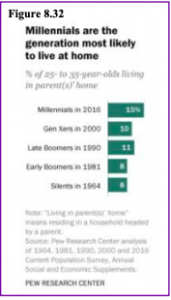
What is the effect on parents when their adult children return home? Certainly, there is considerable research that shows that the stress of raising children can have a negative impact on parents’ well-being and that when children leave home many couples experience less stress and greater life satisfaction (see the section on the empty nest). Early research in the 1980s and 1990s supported the notion that boomerang children, along with those who were failing to exit the home, placed greater financial hardship on the parents, and the parents reported more negative perceptions of this living arrangement (Aquilino, 1991). Recent surveys suggest that today’s parents are more tolerant of this, perhaps because this is becoming a more normative experience than in the past. Moreover, children who return are more likely to have had good relationships with their parents growing up, so there may be less stress between parents and their adult children who return (Sandberg-Thoma et al., 2015). Parents of young adults who have moved back home because of economic reasons report that they are just as satisfied with their life as are parents whose adult children are still living independently (Parker, 2012). Parker found that adult children age 25 and older are more likely to contribute financially to the family or complete chores and other household duties. Parker also found that living in a multigenerational household may be acting as an economic safety net for young adults. In comparison to young adults who were living outside of the home, those living with their parents were less likely to be living in poverty (17% versus 10%).
So far, we have considered the impact that adult children who have returned home or have yet to leave the nest have on the lives of middle-aged parents. What about the effect on parents who have adult children dealing with personal problems, such as alcoholism, chronic health concerns, mental health issues, trouble with the law, poor social relationships, or academic or job-related problems, even if they are not living at home? The life course perspective proposes the idea of linked lives (Greenfield & Marks, 2006). The notion that people in important relationships, such as children and parents, mutually influence each other’s developmental pathways. In previous chapters, you have read about the effects that parents have on their children’s development, but this relationship is bidirectional. The problems faced by children, even when those children are adults, influence the lives of their parents. Greenfield and Marks found in their study of middle-aged parents and their adult children, those parents whose children were dealing with personal problems reported more negative affect, lower self-acceptance, poorer parent-child interactions, and more family relationship stress. The more problems the adult children were facing, the worse the lives and emotional health of their parents, with single parents faring the worst.
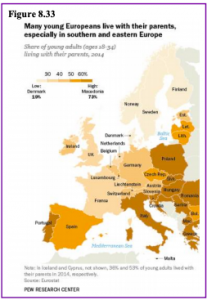
Middle Adult Lifestyles
Singlehood: According to a Pew Research study, 16 per 1,000 adults age 45 to 54 and 7 per 1000 age 55 and over have never married in the U. S. (Wang & Parker, 2014). However, some of them may be living with a partner. In addition, some singles at midlife may be single through divorce or widowhood. DePaulo (2014) has challenged the idea that singles, especially the always single, fair worse emotionally and in health when compared to those married. DePaulo suggests there is a bias in how studies examine the benefits of marriage. Most studies focus on comparisons between married versus not married, which do not include a separate comparison between those always single, and those who are single because of divorce or widowhood. Her research has found that those who are married may be more satisfied with life than the divorced or widowed, but there is little difference between married and always single, especially when comparing those who are recently married with those who have been married for four or more years. It appears that once the initial blush of the honeymoon wears off, those who are wedded are no happier or healthier than those who remained single. This might also suggest that there may be problems with how the “married” category is also seen as one homogeneous group.
Online Dating: Montenegro (2003) surveyed over 3,000 singles aged 40–69, and almost half of the participants reported their most important reason for dating was to have someone to talk to or do things with. Additionally, sexual fulfillment was also identified as an important goal for many. Alterovitz & Mendelsohn (2013) reviewed online personal ads for men and women over age 40 and found that romantic activities and sexual interests were mentioned at similar rates among the middle-age and young-old age groups, but less for the old-old age group.
Marriage: As you read in Chapter 7, there has been a number of changes in the marriage rate as more people are cohabitating, more are deciding to stay single, and more are getting married at a later age. As you can see in Figure 8.34, 48% of adults age 45-54 are married; either in their first marriage (22%) or have remarried (26%). This makes marriage the most common relationship status for middle-aged adults in the United States. Marital satisfaction tends to increase for many couples in midlife as children are leaving home (Landsford, Antonucci, Akiyama, & Takahashi, 2005). Not all researchers agree. They suggest that those who are unhappy with their marriage are likely to have gotten divorced by now, making the quality of marriages later in life only look more satisfactory (Umberson, Williams, Powers, Chen, & Campbell, 2005).
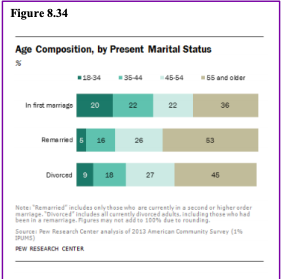
Divorce: Livingston (2014) found that 27% of adults age 45 to 54 were divorced (see Figure 8.32). Additionally, 57% of divorced adults were women. This reflects the fact that men are more likely to remarry than are women. Two-thirds of divorces are initiated by women (AARP, 2009). Most divorces take place within the first 5 to 10 years of marriage. This timeline reflects people’s initial attempts to salvage the relationship. After a few years of limited success, the couple may decide to end the marriage. It used to be that divorce after having been married for 20 or more years was rare, but in recent years the divorce rate among more long-term marriages has been increasing. Brown and Lin (2013) note that while the divorce rate in the U.S. has declined since the 1990s, the rate among those 50 and older has doubled. They suggest several reasons for the “graying of divorce”. There is less stigma attached to divorce today than in the past. Some older women are out-earning their spouses, and thus may be more financially capable of supporting themselves, especially as most of their children have grown. Finally, given increases in human longevity, the prospect of living several more years or decades with an incompatible spouse may prompt middle-aged and older adults to leave the marriage.
Gottman and Levenson (2000) found that the divorces in early adulthood were angrier and conflictual, with each partner blaming the other for the failures in the marriage. In contrast, they found that at midlife divorces tended to be more about having grown apart or cooling off of the relationship. A survey by AARP (2009) found that men and women had diverse motivations for getting a divorce. Women reported concerns about the verbal and physical abusiveness of their partner (23%), drug/alcohol abuse (18%), and infidelity (17%). In contrast, men mentioned they had simply fallen out of love (17%), no longer shared interests or values (14%), and infidelity (14%). Both genders felt their marriage had been over long before the decision to divorce was made, with many of the middle-aged adults in the survey reporting that they stayed together because they were still raising children. Females also indicated that they remained in their marriage due to financial concerns, including the loss of health care (Sohn, 2015). However, only 1 in 4 adults regretted their decision to divorce.
The effects of divorce are varied. Overall, young adults struggle more with the consequences of divorce than do those at midlife, as they have a higher risk of depression or other signs of problems with psychological adjustment (Birditt & Antonucci, 2013). Divorce at midlife is more stressful for women. In the AARP (2009) survey, 44% of middle-aged women mentioned financial problems after divorcing their spouse, in comparison only 11% of men reported such difficulties. However, a number of women who divorce in midlife report that they felt a great release from their day-to-day sense of unhappiness. Hetherington and Kelly (2002) found that among the divorce enhancers, those who had used the experience to better themselves and seek more productive intimate relationships, and the competent loners, those who used their divorce experience to grow emotionally, but who choose to stay single, the overwhelming majority were women.
Dating Post-Divorce: Most divorced adults have dated by one year after filing for divorce (Anderson et al., 2004; Anderson & Greene, 2011). One in four recent filers report having been in or were currently in a serious relationship, and over half were in a serious relationship by one year after filing for divorce. Not surprisingly, younger adults were more likely to be dating than were middle-aged or older adults, no doubt due to the larger pool of potential partners from which they could to draw. Of course, these relationships will not all end in marriage. Teachman (2008) found that more than two-thirds of women under the age of 45 had cohabited with a partnership between their first and second marriages.
Dating for adults with children can be more of a challenge. Courtships are shorter in remarriage than in first marriages. When couples are “dating”, there is less going out and more time spent in activities at home or with the children. So the couple gets less time together to focus on their relationship. Anxiety or memories of past relationships can also get in the way. As one Talmudic scholar suggests “when a divorced man marries a divorced woman, four go to bed.” (Secombe & Warner, 2004).
Post-divorce parents gatekeep, that is, they regulate the flow of information about their new romantic partner to their children, in an attempt to balance their own needs for romance with consideration regarding the needs and reactions of their children. Anderson et al. (2004) found that almost half (47%) of dating parents gradually introduce their children to their dating partner, giving both their romantic partner and children time to adjust and get to know each other. Many parents who use this approach do so to avoid their children having to keep meeting someone new until it becomes clearer that this relationship might be more than casual. It might also help if the adult relationship is on the firmer ground so it can weather any initial push back from children when it is revealed. Forty percent are open and transparent about the new relationship at the outset with their children. Thirteen percent do not reveal the relationship until it is clear that cohabitation and or remarriage is likely. Anderson and colleagues suggest that practical matters influence which gatekeeping method parents may use. Parents may be able to successfully shield their children from a parade of suitors if there is reliable childcare available. The age and temperament of the child, along with concerns about the reaction of the ex-spouse, may also influence when parents reveal their romantic relationships to their children.
Rates of remarriage: The rate for remarriage, like the rate for marriage, has been declining overall. In 2013 the remarriage rate was approximately 28 per 1,000 adults 18 and older. This represents a 44% decline since 1990 and a 16% decline since 2008 (Payne, 2015). Brown and Lin (2013) found that the rate of remarriage dropped more for younger adults than middle-aged and older adults, and Livingston (2014) found that as we age we are more likely to have remarried (see Figure 8.35). This is not surprising as it takes some time to marry, divorce, and then find someone else to marry. However, Livingston found that unlike those younger than 55, those 55 and up are remarrying at a higher rate than in the past. In 2013, 67% of adults 55-64 and 50% of adults 65 and older had remarried, up from 55% and 34% in 1960, respectively.
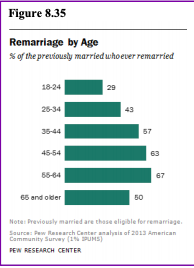
Men have a higher rate of remarriage at every age group starting at age 25 (Payne, 2015). Livingston (2014) reported that in 2013, 64% of divorced or widowed men compared with 52% of divorced or widowed women had remarried. However, this gender gap has narrowed over time. Even though more men still remarry, they are remarrying at a slower rate. In contrast, women are remarrying today more than they did in 1980. This gender gap has closed mostly among young and middle-aged adults but still persists among those 65 and older.
In 2012, Whites who were previously married were more likely to remarry than were other racial and ethnic groups (Livingston, 2014). Moreover, the rate of remarriage has increased among Whites, while the rate of remarriage has declined for other racial and ethnic groups. This increase is driven by White women, whose rate of remarriage has increased, while the rate for White males has declined.
Success of Remarriage: Reviews are mixed as to the happiness and success of remarriages. While some remarriages are more successful, especially if the divorce motivated the adult to engage in self-improvement and personal growth (Hetherington & Kelly, 2002), a number of divorced adults end up in very similar marriages the second or third time around (Hetherington & Kelly, 2002). Remarriages have challenges that are not found in first marriages that may create additional stress in the marital relationship. There can often be a general lack of clarity in family roles and expectations when trying to incorporate new kin into the family structure, even determining the appropriate terms for this kin, along with their roles can be a challenge.
Partners may have to navigate carefully their role when dealing with their partners’ children. All of this may lead to greater dissatisfaction and even resentment among family members. Even though remarried couples tend to have more realistic expectations for marriage, they tend to be less willing to stay in unhappy situations. The rate of divorce among remarriages is higher than among first marriages (Payne, 2015), which can add additional burdens, especially when children are involved.
Children’s Influence on Repartnering: Does having children affect whether a parent remarries? Goldscheider and Sassler (2006) found children residing with their mothers reduces the mothers’ likelihood of marriage, only with respect to marrying a man without children. Further, having children in the home appears to increase single men’s likelihood of marrying a woman with children (Stewart, Manning, & Smock, 2003). There is also some evidence that individuals who participated in a stepfamily while growing up may feel better prepared for stepfamily living as adults. Goldscheider and Kaufman (2006) found that having experienced family divorce as a child is associated with a greater willingness to marry a partner with children.

When children are present after divorce, one of the challenges the adults encounter is how much influence the child will have when selecting a new partner. Greene, Anderson, Hetherington, Forgatch, and DeGarmo (2003) identified two types of parents. The child-focused parent allows the child’s views, reactions, and needs to influence the partnering. In contrast, the adult-focused parent expects that their child can adapt and should accommodate to parental wishes. Anderson and Greene (2011) found that divorced custodial mothers identified as more adult-focused tended to be older, more educated, employed, and more likely to have been married longer. Additionally, adult-focused mothers reported having less rapport with their children, spent less time in joint activities with their children, and the child reported lower rapport with their mothers. Lastly, when the child and partner were resisting one another, adult-focused mothers responded more to the concerns of the partner, while the child-focused mothers responded more to the concerns of the child. Understanding the implications of these two different perspectives can assist parents in their attempts to partner.
Grandparents
In addition to maintaining relationships with their children and aging parents, many people in middle adulthood take on yet another role, becoming a grandparent. The role of grandparents varies around the world. In multigenerational households, grandparents may play a greater role in the day-to-day activities of their grandchildren. While this family dynamic is more common in Latin America, Asia, and Africa, it has been on the increase in the U.S. (Pew Research Center, 2010).
The degree of grandparent involvement also depends on the proximity of the grandparents’ home to their grandchildren. In developed nations, the greater mobility of society can mean that grandparents may live long distances from their grandchildren. Technology has brought grandparents and their more distant grandchildren together. Sorenson and Cooper (2010) found that many of the grandfathers they interviewed would text, email, or Skype with their grandchildren in order to stay in touch.

Cherlin and Furstenberg (1986) described three styles of grandparents. Thirty percent of grandparents were remote as they rarely saw their grandchildren. Usually, they lived far away from their grandchildren but may also have had a distant relationship. Contact was typically made on special occasions, such as holidays or birthdays. Fifty-five percent of grandparents were described as companionate as they did things with their grandchildren but had little authority or control over them. They preferred to spend time with them without interfering in parenting. They were more like friends to their grandchildren. Fifteen percent of grandparents were described as involved as they took a very active role in their grandchild’s life. The involved grandparent had frequent contact with and authority over the grandchild, and their grandchildren might even have lived with them. Grandmothers, more so than grandfathers, played this role. In contrast, more grandfathers than grandmothers saw their role as a family historian and family advisor (Neugarten and Weinstein, 1964).
Bengtson (2001) suggests that grandparents adopt different styles with different grandchildren, and over time may change styles as circumstances in the family change. Today more grandparents are the sole care providers for grandchildren or may step in at times of crisis. With these changes, grandparents are redefining how they see their role in the family with fewer adopting a more formal role (Hayslip, Henderson & Shore, 2003).
Early research on grandparents has routinely focused on grandmothers, with grandfathers often becoming invisible members of the family (Sorensen & Cooper, 2010). Yet, grandfathers stress the importance of their relationships with their grandchildren as strongly as do grandmothers (Waldrop et al., 1999). For some men, this may provide them with the opportunity to engage in activities that their occupations, as well as their generation’s views of fatherhood and masculinity, kept them from engaging in with their own children (Sorenson & Cooper, 2010).
Many of the grandfathers in Sorenson and Cooper’s study felt that being a grandfather was easier and a lot more enjoyable. Even among grandfathers that took on a more involved role, there was still a greater sense that they could be more light-hearted and flexible in their interactions with their grandchildren. Many grandfathers reported that they were more openly affectionate with their grandchildren than they had been with their own children.
Friendships
Adults of all ages who reported having a confidante or close friend with whom they could share personal feelings and concerns believed these friends contributed to a sense of belonging, security, and overall wellbeing (Dunér & Nordstrom, 2007). Having a close friend is a factor in significantly lower odds of psychiatric morbidity including depression and anxiety (Harrison, Barrow, Gask, & Creed, 1999; Newton et al., 2008). The availability of a close friend has also been shown to lessen the adverse effects of stress on health (Kouzis & Eaton, 1998; Hawkley et al., 2008; Tower & Kasl, 1995). Additionally, poor social connectedness in adulthood is associated with a larger risk of premature mortality than cigarette smoking, obesity, and excessive alcohol use (Holt-Lunstad, Smith, & Layton, 2010).
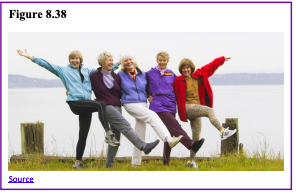
Female friendships and social support networks at midlife contribute significantly to a woman’s feeling of life satisfaction and well-being (Borzumato-Gainey, Kennedy, McCabe, & Degges-White, 2009). Degges-White and Myers (2006) found that women who have supportive people in their life experience greater life satisfaction than do those who live a more solitary life. A friendship network or the presence of a confidant have both been identified for their importance to women’s mental health (Baruch & Brooks-Gunn, 1984). Unfortunately, with numerous caretaking responsibilities at home, it may be difficult for women to find time and energy to enhance the friendships that provide an increased sense of life satisfaction (Borzumato-Gainey et al., 2009). Emslie, Hunt, and Lyons (2013) found that for men in midlife, the shared consumption of alcohol was important to creating and maintaining male friends. Drinking with friends was justified as a way for men to talk to each other, provide social support, relax, and improve mood. Although the social support provided when men drink together can be helpful, the role of alcohol in male friendships can lead to health-damaging behavior from excessive drinking.
The importance of social relationships begins in early adulthood by laying down a foundation for strong social connectedness and facilitating comfort with intimacy (Erikson, 1959). To determine the impact of the quantity and quality of social relationships in young adulthood on middle adulthood, Carmichael, Reis, and Duberstein (2015) assessed individuals at age 50 on measures of social connection (types of relationships and friendship quality) and psychological outcomes (loneliness, depression, psychological well-being). Results indicated that the number of social interactions at age 20 and the quality, not quantity, of social interaction at age 30 predicted midlife social interactions. Those individuals who had high levels of social information seeking (quantity) at age 20 followed by less quantity in social relationships but greater emotional closeness (quality), resulted in positive psychosocial adjustment at midlife.
Continuing to socialize widely in one’s 30s appeared to negatively affect the development of intimacy, and consequently resulted in worse psychological outcomes at age 50.
Internet Friendships: What influence does the Internet have on friendships? It is not surprising that people use the Internet with the goal of meeting and making new friends (Fehr, 2008; McKenna, 2008). Researchers have wondered if the issue of not being face-to-face reduces the authenticity of relationships, or if the Internet really allows people to develop deep, meaningful connections. Interestingly, research has demonstrated that virtual relationships are often as intimate as in-person relationships; in fact, Bargh and colleagues found that online relationships are sometimes more intimate (Bargh, McKenna, & Fitsimons, 2002). This can be especially true for those individuals who are more socially anxious and lonely as such individuals are more likely to turn to the Internet to find new and meaningful relationships (McKenna, Green, & Gleason, 2002). McKenna and colleagues suggest that for people who have a hard time meeting and maintaining relationships, due to shyness, anxiety, or lack of face-to-face social skills, the Internet provides a safe, nonthreatening place to develop and maintain relationships. Similarly, Benford (2008) found that for high-functioning autistic individuals, the Internet facilitated communication and relationship development with others, which would have been more difficult in face-to-face contexts, leading to the conclusion that Internet communication could be empowering for those who feel frustrated when communicating face to face.
Workplace Friendships: Friendships often take root in the workplace, due to the fact that people are spending as much, or more, time at work than they are with their family and friends (Kaufman & Hotchkiss, 2003). Often, it is through these relationships that people receive mentoring and obtain social support and resources, but they can also experience conflicts and the potential for misinterpretation when sexual attraction is an issue. Indeed, Elsesser and Peplau (2006) found that many workers reported that friendships grew out of collaborative work projects, and these friendships made their days more pleasant.

In addition to those benefits, Riordan and Griffeth (1995) found that people who worked in an environment where friendships could develop and be maintained were more likely to report higher levels of job satisfaction, job involvement, and organizational commitment, and they were less likely to leave that job. Similarly, a Gallup poll revealed that employees who had close friends at work were almost 50% more satisfied with their jobs than those who did not (Armour, 2007).
Women in Midlife
In Western society, aging for women is much more stressful than for men as society emphasizes youthful beauty and attractiveness (Slevin, 2010). The description that aging men are viewed as “distinguished” and aging women are viewed as “old” is referred to as the double standard of aging (Teuscher & Teuscher, 2006). Since women have traditionally been valued for their reproductive capabilities, they may be considered old once they are postmenopausal. In contrast, men have traditionally been valued for their achievements, competence, and power, and therefore are not considered old until they are physically unable to work (Carroll, 2016). Consequently, women experience more fear, anxiety, and concern about their identity as they age, and may feel pressure to prove themselves as productive and valuable members of society (Bromberger, Kravitz, & Chang, 2013).
Attitudes about aging, however, do vary by race, culture, and sexual orientation. In some cultures, aging women gain greater social status. For example, as Asian women age, they attain greater respect and have greater authority in the household (Fung, 2013). Compared to white women, Black and Latina’s women possess fewer stereotypes about aging (Schuler et al., 2008). Lesbians are also more positive about aging and looking older than heterosexual women (Slevin, 2010). The impact of media certainly plays a role in how women view aging by selling anti-aging products and supporting cosmetic surgeries to look younger (Gilleard & Higgs, 2000).
Religion and Spirituality
Grzywacz and Keyes (2004) found that in addition to personal health behaviors, such as regular exercise, healthy weight, and not smoking, social behaviors, including involvement in religious-related activities, have been shown to be positively related to optimal health. However, it is not only those who are involved in a specific religion that benefit, but so too do those identified as being spiritual. According to Greenfield, Vaillant, and Marks (2009) religiosity refers to engaging with a formal religious group’s doctrines, values, traditions, and co-members. In contrast, spirituality refers to an individual’s intrapsychic sense of connection with something transcendent (that which exists apart from and not limited by the material universe) and the subsequent feelings of awe, gratitude, compassion, and forgiveness. Research has demonstrated a strong relationship between spirituality and psychological well-being, irrespective of an individual’s religious participation (Vaillant, 2008). Additionally, Sawatzky, Ratner, & Chiu (2005) found that spirituality was related to a higher quality of life for both individuals and societies.

Based on reports from the 2005 National Survey of Midlife in the United States, Greenfield et al. (2009) found that higher levels of spirituality were associated with lower levels of negative affect and higher levels of positive affect, personal growth, purpose in life, positive relationships with others, self-acceptance, environmental mastery, and autonomy. In contrast, formal religious participation was only associated with higher levels of purpose in life and personal growth among just older adults and lower levels of autonomy. In summary, it appears that formal religious participation and spirituality relate differently to an individual’s overall psychological well-being.
Age: Older individuals identify religion/spirituality as being more important in their lives than those younger (Beit-Hallahmi & Argyle, 1998). This age difference has been explained by several factors including that religion and spirituality assist older individuals in coping with age-related losses, provide opportunities for socialization and social support in later life, and demonstrate a cohort effect in that older individuals were socialized more to be religious and spiritual than those younger (Greenfield et al., 2009).
Gender: In the United States, women report identifying as being more religious and spiritual than men do (de Vaus & McAllister, 1987). According to the Pew Research Center (2016), women in the United States are more likely to say religion is very important in their lives than men (60% vs. 47%). American women also are more likely than American men to say they pray daily (64% vs. 47%) and attend religious services at least once a week (40% vs. 32%). Theories to explain this gender difference include that women may benefit more from the social-relational aspects of religion/spirituality because social relationships more strongly influence women’s mental health. Additionally, women have been socialized to internalize the behaviors linked with religious values, such as cooperation and nurturance, more than males (Greenfield et al., 2009).
Worldwide: To measure the religious beliefs and practices of men and women around the world, the Pew Research Center (2016) conducted surveys of the general population in 84 countries between 2008 and 2015. Overall, an estimated 83% of women worldwide identified with religion compared with 80% of men. This equaled 97 million more women than men identifying with a religion. There were no countries in which men were more religious than women by 2 percentage points or more. Among Christians, women reported higher rates of weekly church attendance and higher rates of daily prayer. In contrast, Muslim women and Muslim men showed similar levels of religiousness, except the frequency of attendance at worship services. Because of religious norms, Muslim men worshiped at a mosque more often than Muslim women. Similarly, Jewish men attended a synagogue more often than Jewish women. In Orthodox Judaism, communal worship services cannot take place unless a minyan, or quorum of at least 10 Jewish men, is present, thus ensuring that men will have high rates of attendance. Only in Israel, where roughly 22% of all Jewish adults self-identify as Orthodox, did a higher percentage of men than women report engaging in daily prayer.

References
AARP. (2009). The divorce experience: A study of divorce at midlife and beyond. Washington, DC: AARP
Ahlborg, T., Misvaer, N., & Möller, A. (2009). Perception of marital quality by parents with small children: A follow-up study when the firstborn is 4 years old. Journal of Family Nursing, 15, 237–263.
Alterovitz, S. S., & Mendelsohn, G. A. (2013). Relationship goals of middle-aged, young-old, and old-old Internet daters: An analysis of online personal ads. Journal of Aging Studies, 27, 159–165. doi.10.1016/j.jaging.2012.12.006
American Association of Community Colleges (2016). Plus 50 community colleges: Ageless learning. Retrieved from http://plus50.aacc.nche.edu/Pages/Default.aspx
American Cancer Society. (2019). Cancer Facts and Figures 2019. Retrieved from https://www.cancer.org/content/dam/cancer- org/research/cancer-facts-and-statistics/annual-cancer-facts-and-figures/2019/cancer-facts-and-figures-2019.pdf
American Diabetes Association (2016). Standards of medical care in diabetes. Diabetes Care. 39(1), 1-112.
American Heart Association (2016). Saturated fats. Retrieved from http://www.heart.org/HEARTORG/HealthyLiving/HealthyEating/Nutrition/Saturated-Fats_UCM_301110_Article.jsp
American Psychological Association (2017). Stress in America: The state of our nation. Retrieved from https://www.apa.org/images/state-nation_tcm7-225609.pdf
American Psychological Association (2016). By the numbers: Hearing loss and mental health. Monitor on Psychology, 47(4), 9.
Anderson, E. R., & Greene, S. M. (2011). “My child and I are a package deal”: Balancing adult and child concerns in repartnering after divorce. Journal of Family Psychology, 25(5), 741-750.
Anderson, E.R., Greene, S.M., Walker, L., Malerba, C.A., Forgatch, M.S., & DeGarmo, D.S. (2004). Ready to take a chance again: Transitions into dating among divorced parents. Journal of Divorce and Remarriage, 40, 61-75.
Aquilino, W. (1991). Predicting parents’ experiences with coresidence adult children. Journal of Family Issues, 12(3), 323-342.
Arai, Y., Sugiura, M., Miura, H., Washio, M., & Kudo, K. (2000). Undue concern for other’s opinions deters caregivers of impaired elderly from using public services in rural Japan. International Journal of Geriatric Psychiatry, 15(10), 961- 968.
Armour, S. (2007, August 2). Friendships and work: A good or bad partnership? USA Today. Retrieved from http://usatoday30.usatoday.com/money/workplace/2007-08-01-work-friends_N.htm
Avis, N. E., Stellato, R., & Crawford, S. (2001). Is there a menopausal syndrome? Menopausal status and symptoms across racial/ethnic groups. Social Science and Medicine, 52(3), 345-356.
Baltes, P. B., Staudinger, U. M., & Lindenberger, U. (1999). Lifespan Psychology: Theory and Application to Intellectual Functioning. Annual Review of Psychology, 50, 471-507.
Bargh, J. A., McKenna, K. Y. A, & Fitsimons, G. G. (2002). Can you see the real me? Activation and expression of the true self on the Internet. Journal of Social Issues, 58, 33–48.
Barreto, M., Ryan, M. K., & Schmitt, M. T. (2009). The glass ceiling in the 21st century: Understanding the barriers to gender equality. Washington, DC: American Psychological Association.
Baruch, G., & Brooks-Gunn, J. (1984). Women in midlife. New York: Plenum.
Beach, S. R., Schulz, R., Yee, J. L., & Jackson, S. (2000). Negative and positive health effects of caring for a disabled spouse: Longitudinal findings from the caregiver health effects study. Psychology and Aging, 15(2), 259-271.
Beit-Hallahmi, B., & Argyle, M. (1998). Religious behavior, belief, and experience. New York: Routledge.
Bengtson, V. L. (2001). Families, intergenerational relationships, and kinkeeping in midlife. In N. M. Putney (Author) & M. E. Lachman (Ed.), Handbook of midlife development (pp. 528-579). New York: Wiley.
Berglund, L., Oliver, E. H., Fontanez, N., Holleran, S., Matthews, K., Roheim, P. S., & DELTA Investigators. (1999). HDL- subpopulation patterns in response to reductions in dietary total and saturated fat intakes in healthy subjects. American Journal of Clinical Nutrition, 70, 992-1000.
Berkeley Wellness. (2011). The lowdown on low testosterone. Retrieved from http://www.berkeleywellness.com/self- care/sexual-health/article/lowdown-low-testosterone
Besen, E., Matz-Costa, C., Brown, M., Smyer, M. A., & Pitt-Catsouphers, M. (2013). Job characteristics, core self-evaluations, and job satisfaction. International Journal of Aging & Human Development, 76(4), 269-295.
Billings, A. G., & Moos, R. H. (1981). The role of coping responses and social resources in attenuating the stress of life events. Journal of Behavioral Medicine, 4, 139–157.
Birditt, K. S., & Antonucci, T.C. (2012). Till death do us part: Contexts and implications of marriage, divorce, and remarriage across adulthood. Research in Human Development, 9(2), 103-105.
Borland, D. C. (1982). A cohort analysis approach to the empty-nest syndrome among three ethnic groups of women: A theoretical position. Journal of Marriage and the Family, 44, 117–129.
Borzumato-Gainey, C., Kennedy, A., McCabe, B., & Degges-White, S. (2009). Life satisfaction, self-esteem, and subjective age in women across the life span. Adultspan Journal, 8(1), 29-42.
Bouchard, G. (2013). How do parents reaction when their children leave home: An integrative review. Journal of Adult Development, 21, 69-79.
Bromberger, J. T., Kravitz, H. M., & Chang, Y. (2013). Does risk for anxiety increase during the menopausal transition? Study of Women’s Health Across the Nation (SWAN). Menopause, 20(5), 488-495.
Brown, L. H., & DeRycke, S. B. (2010). The kinkeeping connection: Continuity, crisis and consensus. Journal of Intergenerational Relationships, 8(4), 338-353, DOI: 10.1080/15350770.2010.520616
Brown, S. L., & Lin, I. (2013). The gray divorce revolution: Rising divorce among middle aged and older adults 1990-2010. National Center for Family & Marriage Research Working Paper Series. Bowling Green State University. https://www.bgsu.edu/content/dam/BGSU/college-of-arts-and- sciences/NCFMR/ documents/Lin/The-Gray- Divorce.pdf
Bureau of Labor Statistics. (2019). The employment situation-June 2019. Retrieved from: https://www.bls.gov/news.release/pdf/empsit.pdf
Busse, E. W. (1969). Theories of aging. In E. W. Busse & E/. Pfeiffer (Eds.), Behavior and adaptation in later life (pp. 11-31). Boston, MA: Little Brown.
Carmichael, C. L., Reis, H. T., & Duberstein, P. R. (2015). In your 20s it’s quantity, in your 30s it’s quality: The prognostic value of social activity across 30 years of adulthood. Psychology and Aging, 30(1), 95-105.
Carroll, J. L. (2016). Sexuality now: Embracing diversity (5th ed.). Boston, MA: Cengage Learning.
Carver, C. S., Scheier, M. F., & Weintraub, J. K. (1989). Assessing coping strategies: A theoretically based approach. Journal of Personality and Social Psychology, 56, 267–283.
Center for Sexual Health Promotion. (2010). National survey of sexual health and behavior. Retrieved from http://www.sexualhealth.indiana.edu
Centers for Disease Control (2014a). About high blood pressure. Retrieved from http://www.cdc.gov/bloodpressure/about.htm
Centers for Disease Control and Prevention. (2014b). Behaviors that increase the risk for high blood pressure. Retrieved from http://www.cdc.gov/bloodpressure/behavior.htm
Centers for Disease Control and Prevention. (2014c). Measuring high blood pressure. Retrieved from http://www.cdc.gov/bloodpressure/measure.htm
Centers for Disease Control and Prevention. (2014d). National diabetes statistics report, 2014. Retrieved from http://www.cdc.gov/diabetes/pubs/statsreport14/national-diabetes-report-web.pdf
Centers for Disease Control and Prevention. (2014e). Diagnoses of HIV infection among adults aged 50 years and older in the United States and dependent areas 2010–2014. HIV surveillance report, 21(2), 1-69. Retrieved from http://www.cdc.gov/hiv/pdf/library/reports/surveillance/cdc-hiv-surveillance-supplemental-report-vol-21-2.pdf
Centers for Disease Control and Prevention. (2015). Facts about high cholesterol. Retrieved from http://www.cdc.gov/cholesterol/facts.htm
Centers for Disease Control and Prevention. (2016). The National Center for Health Statistics. Retrieved from https://www.cdc.gov/nchs/index.htm
Centers for Disease Control and Prevention. (2017). National diabetes statistics report, 2017. Retrieved from: https://www.cdc.gov/diabetes/pdfs/data/statistics/national-diabetes-statistics-report.pdf
Chang, Y. F., An, Y., Bigel, M., Wong, D. F., Troncoso, J. C., O’Brien, R. J., Breitner, J. C., Ferruci, L., Resnick, S. M., & Thanbisetty, M. (2016). Midlife adiposity predicts earlier onset of Alzheimer’s dementia, neuropathology and presymptomatic cerebral amyloid accumulation. Molecular Psychiatry, 21(7), 910-915.
Charness, N., & Krampe, R. T. (2006). Aging and expertise. In K. Ericsson, N. Charness & P. Feltovich (Eds.), Cambridge Handbook of expertise and expert performance. Cambridge, United Kingdom: Cambridge University Press.
Cherlin, A. J., & Furstenberg, F. F. (1986). The new American grandparent: A place in the family, a life apart. New York: Basic Books.
Cohen, S., & Wills, T. A. (1985). Stress, social support, and the buffering hypothesis. Psychological Bulletin, 98, 310–357.
Crawford, S. & Channon, S. (2002). Dissociation between performance on abstract tests of executive function and problem solving in real life type situations in normal aging. Aging and Mental Health, 6, 12-21.
Crist, L. A., Champagne, C. M., Corsino, L., Lien, L. F., Zhang, G., & Young, D. R. (2012). Influence of change in aerobic fitness and weight on prevalence of metabolic syndrome. Preventing Chronic Disease 9,110171. doi: http://dx.doi.org/10.5888/pcd9.110171
Crowson, C. S., Matteson, E. L., Myasoedova, E., Michet, C. J., Ernste, F. C., Warrington, K. J., …Gabriel, S. E. (2011). The lifetime risk of adult-onset rheumatoid arthritis and other inflammatory autoimmune rheumatic diseases. Arthritis and Rheumatism, 63(3), 633-639. doi: 10.1002/art.30155.
Csikszentmihalyi, M. (1990). Flow: The psychology of optimal experience. New York: Harper Perennial Modern Classics.
Csikszentmihalyi, M. (1996). Creativity: Flow and the psychology of discovery and invention. New York: Harper
Collins. Dawes, P., DicMonrokinson, C., Emsley, R., Bishop, P. N., Cruickshanks, K. J., Edmundson-Jones, M., …. Munro, K. (2014). Vision impairment and dual sensory problems in middle age. Ophthalmic Physiological Optics, 34, 479–488. doi: 10.1111/opo.12138479
Degges-White, S., & Myers, J, E. (2006). Women at midlife: An exploration of chronological age, subjective age, wellness, and life satisfaction, Adultspan Journal, 5, 67-80.
DeLongis, A., Folkman, S., & Lazarus, R. S. (1988). The impact of daily stress on health and mood: Psychological and social resources as mediators. Journal of Personality and Social Psychology, 54, 486–495.
Dennerstein, L., Dudley, E., & Guthrie, J. (2002). Empty nest or revolving door? A prospective study of women’s quality of life in midlife during the phase of children leaving and re-entering the home. Psychological Medicine, 32, 545–550.
DePaulo, B. (2014). A singles studies perspective on mount marriage. Psychological Inquiry, 25(1), 64-68. doi: 10.1080/1047840X.2014.878173
Desilver, D. (2016). In the U. S. and abroad, more young adults are living with their parents. Retrieved from: https://www.pewresearch.org/fact-tank/2016/05/24/in-the-u-s-and-abroad-more-young-adults-are-living-with-their- parents/
de St. Aubin, E., & Mc Adams, D. P. (1995). The relation of generative concern and generative action to personality traits, satisfaction/happiness with life and ego development. Journal of Adult Development, 2, 99-112.
De Vaus, D. & McAllister, I. (1987). Gender differences in religion: A test of the structural location theory. American Sociological Review, 52, 472-481.
Dew, M. A., Hoch, C. C., Buysse, D. J., Monk, T. H., Begley, A. E., Houck, P. R.,…Reynolds, C. F., III. (2003). Healthy older adults’ sleep predicts all-cause mortality at 4 to 19 years of follow-up. Psychosomatic Medicine, 65(1), 63–73.
Dimah, K., & Dimah, A. (2004). Intimate relationships and sexual attitudes of older African American men and women. The Gerontologist, 44, 612-613.
Drake, B. (2013). Another gender gap: Men spend more time in leisure activities. Pew Research Center. Retrieved from http://www.pewresearch.org/fact-tank/2013/06/10/another-gender-gap-men-spend-more-time-in-leisure-activities/
Dunér, A., & Nordstrom, M. (2007). The roles and functions of the informal support networks of older people who receive formal support: A Swedish qualitative study. Ageing & Society, 27, 67– 85. doi:10.1017/ S0144686X06005344
Easterlin, R. A. (2006). Life cycle happiness and its sources: Intersections of psychology, economics, and demography. Journal of Economic Psychology, 27, 463-482.
Eastley, R., & Wilcock, G. K. (1997). Prevalence and correlates of aggressive behaviors occurring in patients with Alzheimer’s disease. International Journal of Geriatric Psychiatry, 12, 484-487.
Elsesser, L., & Peplau, L. A. (2006). The glass partition: Obstacles to cross-sex friendships at work. Human Relations, 59(8), 1077–1100.
Emslie, C., Hunt, K., & Lyons, A. (2013. The role of alcohol in forging and maintaining friendships amongst Scottish men in midlife. Health Psychology, 32(10, 33-41.
Ericsson, K. A., Feltovich, P. J., & Prietula, M. J. (2006). Studies of expertise from psychological perspectives. In K. Ericsson, N. Charness & P. Feltovich (Eds.), Cambridge Handbook of expertise and expert performance. Cambridge, UK: Cambridge University Press.
Erikson, E. (1950). Childhood and society. New York: Norton & Company. Erikson, E. (1959). Identity and the life cycle. New York: Norton & Company. Erikson, E. (1982). The life cycle completed. New York: Norton & Company.
Fehr, B. (2008). Friendship formation. In S. Sprecher, A. Wenzel, & J. Harvey (Eds.), Handbook of Relationship Initiation (pp.29–54). New York, NY: Psychology Press.
Ferrie, J. E., Shipley, M. J., Cappuccio, F. P., Brunner, E., Miller, M. A., Kumari, M., & Marmot, M. G. (2007). A prospective study of change in sleep duration: Associations with mortality in the Whitehall II cohort. Sleep, 30(12), 1659.
Ford, E. S., Li, C., & Zhao, G. (2010). Prevalence and correlates of metabolic syndrome based on a harmonious definition among adults in the US. Journal of Diabetes, 2(3), 180-193.
Friedman, M., & Rosenman, R. (1959). Association of specific overt behaviour pattern with blood and cardiovascular findings. Journal of the American Medical Association, 169, 1286–1296.
Fry, R. (2017). It’s becoming more common for young adults to live at home-and for longer stretches. Retrieved from: https://www.pewresearch.org/fact-tank/2017/05/05/its-becoming-more-common-for-young-adults-to-live-at-home-and- for-longer-stretches/ft_17-05-03_livingathome_bygen2/
Füllgrabe, C., Moore, B. C. J., & Stone, M. A. (2015). Age-group differences in speech identification despite matched audio metrically normal hearing: contributions from auditory temporal processing and cognition. Frontiers in Aging Neuroscience, 6, 1-25. doi:10.3389/fnagi.2014.00347
Fung, H. H. (2013). Aging in culture. Gerontologist, 53(3), 369-377.
Gerstel, N., & Gallagher, S. K. (1993). Kinkeeping and distress: Gender, recipients of care, and work–family conflict. Journal of Marriage and the Family, 55, 598–607.
Gibbons, C., Creese, J., Tran, M., Brazil, K., Chambers, L., Weaver, B., & Bedard, M. (2014). The psychological and health consequences of caring for a spouse with dementia: A critical comparison of husbands and wives. Journal of Women & Aging, 26, 3-21.
Gilleard, C., & Higgs, P. (2000). Cultures of aging: Self, citizen and the body. Upper Saddle River, NJ: Prentice Hall Publishers.
Goldscheider, F., & Kaufman, G. (2006). Willingness to stepparent: Attitudes about partners who already have children. Journal of Family Issues, 27, 1415 – 1436.
Goldscheider, F., & Sassler, S. (2006). Creating stepfamilies: Integrating children into the study of union formation. Journal of Marriage and Family, 68, 275 – 291.
Gorchoff, S. M., John, O. P., & Helson, R. (2008). Contextualizing change in marital satisfaction during middle age. Psychological Science, 19, 1194–1200.
Gottman, J. M., & Levenson, R. W. (2000). The timing of divorce: Predicting when a couple will divorce over a 14-year period. Journal of Marriage & the Family, 62, 737-745.
Greene, S. M., Anderson, E. R., Hetherington, E., Forgtch, M. S., & DeGarmo, D. S. (2003). Risk and resilience after divorce. In F. Walsh (Ed.), Normal family processes: Growing diversity and complexity (3rd ed., pp. 96-120). New York: Guilford Press.
Greenfield, E. A., & Marks, N. F. (2006). Linked lives: Adult children’s problems and their parents’ psychological and relational well-being. Journal of Marriage and Family, 68, 442-454.
Greenfield, E. A., Vaillant, G. E., & Marks, N. F. (2009). Do formal religious participation and spiritual perceptions have independent linkages with diverse dimensions of psychological well-being? Journal of Health and Social Behavior, 50, 196-212.
Gripsrud, J. (2007). Television and the European public sphere. European Journal of Communication, 22, 479-492.
Grzywacz, J. G. & Keyes, C. L. (2004). Toward health promotion: Physical and social behaviors in complete health. Journal of Health Behavior, 28(2), 99-111.
Ha, J., Hong, J., Seltzer, M. M., & Greenberg, J. S. (2008). Age and gender differences in the well-being of midlife and aging parents with children with mental health or developmental problems: Report of a national study. Journal of Health and Social Behavior, 49, 301-316.
Harrison, J., Barrow, S., Gask, L., & Creed, F. (1999). Social determinants of GHQ score by postal survey. Journal of Public Health Medicine, 21, 283–288. doi:10.1093/pubmed/21.3.283
Hawkley, L. C., Hughes, M. E., Waite, L. J., Masi, C. M., Thisted, R. A., & Cacioppo, J. T. (2008). From social structural factors to perceptions of relationship quality and loneliness: The Chicago health, aging, and marital status transitions and health outcomes social relations study. The Journals of Gerontology: Series B: Psychological Sciences and Social Sciences, 63, 375–384. doi:10.1093/geronb/ 63.6.S375
Hayslip Jr., B., Henderson, C. E., & Shore, R. J. (2003). The Structure of Grandparental Role Meaning. Journal of Adult Development, 10(1), 1-13.
Hedlund, J., Antonakis, J., & Sternberg, R. J. (2002). Tacit knowledge and practical intelligence: Understanding the lessons of experience. Retrieved from http://www.au.af.mil/au/awc/awcgate/army/ari_tacit_knowledge.pdf
Herman-Stabl, M. A., Stemmler, M., & Petersen, A. C. (1995). Approach and avoidant coping: Implications for adolescent mental health. Journal of Youth and Adolescence, 24, 649–665.
Hetherington, E. M. & Kelly, J. (2002). For better or worse: Divorce reconsidered. New York, NY: Norton.
Holland, K. (2014). Why America’s campuses are going gray. CNBC. Retrieved from http://www.cnbc.com/2014/08/28/why- americas-campuses-are-going-gray.html
Holt-Lunstad, J., Smith, T. B., & Layton, J. B. (2010). Social relationships and mortality risk: a meta-analytic review. PLoS Medicine, 7(7), e1000316.
Hooker, E., & Pressman, S. (2016). The healthy life. NOBA. Retrieved from http://nobaproject.com/modules/the-healthy-life
Horn, J. L., Donaldson, G., & Engstrom, R. (1981). Apprehension, memory, and fluid intelligence decline in adulthood. Research on Aging, 3(1), 33-84.
House, J. S., Landis, K. R., & Umberson, D. (1988). Social relationships and health. Science, 241, 540–545
Hu, G., Qiao, Q., Tuomilehto, J., Balkau, B., Borch, Johnsen, K., & Pyorala, K. (2004). Prevalence of metabolic syndrome and its relation to all-cause and cardiovascular mortality in non-diabetic European men and women. Archives of Internal Medicine, 164(10), 1066-1076.
Huang, J. (2007). Hormones and female sexuality. In M. Tepper & A. F. Owens (Eds.), Sexual Health, Vol 2: Physical Foundations (pp. 43-78). Westport, CT: Praeger.
Humes, L. E., Kewley-Port, D., Fogerty, D., & Kinney, D. (2010). Measures of hearing threshold and temporal processing across the adult lifespan. Hearing Research, 264(1/2), 30-40. doi:10.1016/j.heares.2009.09.010
International Labour Organization. (2011). Global Employment Trends: 2011. Retrieved from http://www.ilo.org/wcmsp5/groups/public/@dgreports/@dcomm/@publ/documents/publication/wcms_150440.pdf
Iribarren, C., Sidney, S., Bild, D. E., Liu, K., Markovitz, J. H., Roseman, J. M., & Matthews, K. (2000). Association of hostility with coronary artery calcification in young adults. Journal of the American Medical Association, 283, 2546–2551.
Jackson, G. R. & Owsley, C. (2000). Scotopic sensitivity during adulthood. Vision Research, 40 (18), 2467-2473. doi:10.1016/S0042-6989(00)00108-5
Jones, J. M. (2013). In U.S., 40% Get Less than Recommended Amount of Sleep. Gallup. Retrieved from http://www.gallup.com/poll/166553/less-recommended- amount sleep.aspx?g_source=sleep%202013&g_medium=search&g_campaign=tiles
Kagawa-Singer, M., Wu, K., & Kawanishi, Y. (2002). Comparison of the menopause and midlife transition between Japanese American and European American women. Medical Anthropology Quarterly, 16(1), 64-91.
Kang, S. W., & Marks, N. F. (2014). Parental caregiving for a child with special needs, marital strain, and physical health: Evidence from National Survey of Midlife in the U.S. 2005. Contemporary Perspectives in Family Research, 8A, 183- 209.
Karakelides, H., & Nair, K. S. (2005). Sarcopenia of aging and its metabolic impact. Current Topics in Developmental Biology, 68, 123-148.
Kasper, T. (2015). Why you only need 7 hours of sleep. American Academy of Sleep Medicine. Retrieved from http://sleepeducation.org/news/2015/06/03/why-you-only-need-7-hours-of-sleep
Kaufman, B. E., & Hotchkiss, J. L. 2003. The economics of labor markets (6th ed.). Mason, OH: Thomson South-Western.
Kaufman, S. B., & Gregoire, C. (2016). How to cultivate creativity. Scientific American Mind, 27(1), 62-67.
Kaur, S., Walia, I., & Singh, A. (2004). How menopause affects the lives of women in suburban Chandigarh, India. Climacteric, 7(2), 175-180.
Knowles, M. S., Holton, E. F., & Swanson, R. A. (1998). The adult learner: A neglected species. Houston: Gulf Pub., Book Division.
Kochanek, K. D., Murphy, S. L., Xu, J., & Arias, E. (2019). Deaths: Final data for 2017. National Vital Statistics Reports, 68(9), 1-77.
Kouzis, A. C., & Eaton, W. W. (1998). Absence of social networks, social support, and health services utilization. Psychological Medicine, 28, 1301–1310. doi:10.1017/S0033291798007454
Krause, N. A., Herzog, R., & Baker, E. (1992). Providing support to others and well-being in later life. Journal of Gerontology: Psychological Sciences, 47, P300-311.
Kühnel, J., & Sonnentag, S. (2011). How long do you benefit from vacation? A closer look at the fade-out vacation effects. Journal of Organizational Behavior, 32, 125-143.
Kushida, C. (2005). Sleep deprivation: basic science, physiology, and behavior. London, England: Informal Healthcare.
Lachman, M. E. (2004). Development in midlife. Annual Review of Psychology, 55(1), 305-331. doi: 10.1146/annurev.psych.55.090902.141521
Landsford, J. E., Antonucci, T.C., Akiyama, H., & Takahashi, K. (2005). A quantitative and qualitative approach to social relationships and well-being in the United States and Japan. Journal of Comparative Family Studies, 36, 1-22.
Leach, M. S., & Braithwaite, D. O. (1996). A binding tie: Supportive communication of family kinkeepers. Journal of Applied Communication Research, 24, 200–216.
Lee, B., Lawson, K. M., Chang, P., Neuendorf, C., Dmitrieva, N. O., & Ameida, D. H. (2015). Leisure-time physical activity moderates the longitudinal associations between work-family spillover and physical health. Journal of Leisure Research, 47(4), 444-466.
Levinson, D. J. (1978). The seasons of a man’s life. New York: Knopf.
Livingston, G. (2014). Four in ten couples are saying I do again. In Chapter 3. The differing demographic profiles of first-time marries, remarried and divorced adults. Pew Research Center. Retrieved from http://www.pewsocialtrends.org/2014/11/14/chapter-3-the-differing-demographic-profiles-of-first-time-married- remarried-and-divorced-adults/
Madden, S., St Pierre-Hansen, N., & Kelly L. (2010). First Nations women’s knowledge of menopause: Experiences and perspectives. Canadian Family Physician, 56(9), e331-e337.
Malik, S. (2004). Impact of the metabolic syndrome on mortality from coronary heart disease, cardiovascular disease, and all causes in United States adults. Circulation, 110(10), 1245-1250.
Malone, J. C., Liu, S. R., Vaillant, G. E., Rentz, D. M., & Waldinger, R. J. (2016). Midlife Eriksonian psychosocial development: Setting the stage for late-life cognitive and emotional health. Developmental Psychology, 52(3), 496-508.
Marketing Charts Staff. (2014). Are young people watching less TV? Retrieved from http://www.marketingcharts.com/television/are-young-people-watching-less-tv-24817/
Martin, L. J. (2014). Aging changes in hair and nails. U.S. National Library of Medicine. Retrieved from https://www.nlm.nih.gov/medlineplus/ency/article/004005.htm
Matthews, K. A., Glass, D. C., Rosenman, R. H., & Bortner, R. W. (1977). Competitive drive, pattern A, and coronary heart disease: A further analysis of some data from the Western Collaborative Group Study. Journal of Chronic Diseases, 30, 489–498.
Mayo Clinic. (2014a). Heart disease. Retrieved from http://www.mayoclinic.org/diseases-conditions/heart- disease/basics/definition/con-20034056
Mayo Clinic. (2014b). Metabolism and weight loss: How you burn calories. Retrieved from http://www.mayoclinic.org/healthy- lifestyle/weight-loss/in-depth/metabolism/art-20046508
McKenna, K. A. (2008) MySpace or your place: Relationship initiation and development in the wired and wireless world. In S. Sprecher, A. Wenzel, & J. Harvey (Eds.), Handbook of relationship initiation (pp. 235–247). New York, NY: Psychology Press.
McKenna, K. A., Green, A. S., & Gleason, M. E. J. (2002). Relationship formation on the Internet: What’s the big attraction? Journal of Social Issues, 58, 9–31.
Metlife. (2011). Metlife study of caregiving costs to working caregivers: Double jeopardy for baby boomers caring for their parents. Retrieved from http://www.caregiving.org/wp-content/uploads/2011/06/mmi-caregiving-costs-working- caregivers.pdf
Maillard, P., Sashardi, S., Beiser, A., Himail, J. J., Au, R., Fletcher, E., …. DeCarli, C. (2012). Effects of systolic blood pressure on white-matter integrity in young adults in the Farmington Heart Study: A cross-sectional study. The Lancet: Neurology, 11(12), 1039-1047.
Miller, T. Q., Smith, T. W., Turner, C. W., Guijarro, M. L., & Hallet, A. J. (1996). Meta-analytic review of research on hostility and physical health. Psychological Bulletin, 119, 322–348.
Mitchell, B. A., & Lovegreen, L. D. (2009). The empty nest syndrome in midlife families: A multimethod exploration of parental gender differences and cultural dynamics. Journal of Family Issues, 30, 1651–1670.
Montenegro, X. P. (2003). Lifestyles, dating, and romance: A study of midlife singles. Washington, DC: AARP.
Monthly Labor Review. (2013). Percentage of the non-institutionalized civilian workforce employed by gender & age. Retrieved from http://www.bls.gov/cps/cps_aa2013.htm
Moravec, C. S. (2008). Biofeedback therapy in cardiovascular disease: rationale and research overview. Cleveland Clinic Journal of Medicine, 75, S35–S38.
Morita, Y., Iwamoto, I., Mizuma, W., Kuwahata, T., Matsuo, T., Yoshinaga, M., &Douchi, T. (2006). Precedence of the shift of body-fat distribution over the change in body composition after menopause. Journal of Obstetrics and Gynecology, 32, 513-516.
Morley, J. E., Baumgartner, R. N., Roubenoff, R., Mayer, J., & Nair, K. S. (2001). Sarcopenia. Journal of Laboratory and Clinical Medicine, 137(4), 231-243.
Moskowitz, R. J. (2014). Wrinkles. U. S. National Library of Medicine. Retrieved from https://www.nlm.nih.gov/medlineplus/ency/article/003252.htm
Nakamura, J., & Csikszentmihalyi, M. (2002). The concept of flow. In C. R. Snyder & S. J. Lopez (Eds.), Handbook of positive psychology (pp. 89-105). New York: Oxford University Press.
Nassir, F., Rector, S., Hammoud, G.M., & Ibdah, J.A. (2015). Pathogenesis and prevention of hepatic steatosis. Gastroenterology & Hepatology, 11(3), 167-175.
National Alliance for Caregiving. (2015). Caregiving in the U.S. 2015. Retrieved from http://www.caregiving.org/caregiving2015.
National Eye Institute. (2009). Facts about floaters. Department of Health and Human Services. Retrieved from https://nei.nih.gov/health/floaters/floaters
National Eye Institute. (2013). Facts about dry eye. Department of Health and Human Services. Retrieved from https://nei.nih.gov/health/dryeye/dryeye
National Eye Institute. (2015). Facts about diabetic eye disease. Retrieved from: https://nei.nih.gov/health/diabetic/retinopathy
National Eye Institute. (2016). Facts about presbyopia. Department of Health and Human Services. Retrieved from https://nei.nih.gov/health/errors/presbyopia
National Institutes of Health. (2007). Menopause: MedlinePlus Medical Encyclopedia. Retrieved from http://www.nlm.nih.gov/medlineplus/ency/article/000894.htm
National Institutes of Health. (2013). Gallstones. U.S. Department of Health and Human Services. Retrieved from http://www.niddk.nih.gov/health-information/health-topics/digestive-diseases/gallstones/Pages/facts.aspx
National Institutes of Health. (2014a). The A1C and diabetes. Retrieved from http://www.niddk.nih.gov/health- information/health-topics/diagnostic-tests/a1c-test-diabetes/Pages/index.aspx
National Institutes of Health (2014b). Age changes in the lungs. Retrieved from https://www.nlm.nih.gov/medlineplus/ency/article/004011.htm
National Institutes of Health (2014c). Sweet stuff: How sugars and sweeteners affect your health. Retrieved from https://newsinhealth.nih.gov/issue/oct2014/feature1
National Institutes of Health. (2014d). What is atherosclerosis? Retrieved from http://www.nhlbi.nih.gov/health/health- topics/topics/atherosclerosis
National Institutes of Health. (2015). Cancer. Retrieved from https://www.cancer.gov/about-cancer/understanding/what-is-cancer
National Institutes of Health. (2016a). Facts about diabetes. Retrieved from http://www.niddk.nih.gov/health-information/health- topics/Diabetes/diabetes-facts/Pages/default.aspx
National Institutes of Health (2016b). Handout on Health: Rheumatoid Arthritis. Retrieved from http://www.niams.nih.gov/health%5Finfo/rheumatic%5Fdisease/
National Institutes of Health. (2016c). Older drivers: How health affects driving. Retrieved from http://nihseniorhealth.gov/olderdrivers/howhealthaffectsdriving/01.html
National Sleep Foundation. (2015). 2015 Sleep in America™ poll finds pain a significant challenge when it comes to Americans’ sleep. National Sleep Foundation. Retrieved from https://sleepfoundation.org/media-center/press-release/2015-sleep- america-poll
National Sleep Foundation. (2016). Menopause and Insomnia. National Sleep Foundation. Retrieved from https://sleepfoundation.org/ask-the-expert/menopause-and-insomnia
Neidleman, M. T., Wambacq, I., Besing, J., Spitzer, J. B., & Koehnke, J. (2015). The Effect of Background Babble on Working Memory in Young and Middle-Aged Adults. Journal of the American Academy of Audiology, 26(3), 220-228. doi:10.3766/jaaa.26.3.3
Neugarten, B. L. (1968). The awareness of middle aging. In B. L. Neugarten (Ed.), Middle age and aging (pp. 93-98). Chicago: University of Chicago Press.
Neugarten, B. L., & Weinstein, K. K. (1964). The changing American grandparent. Journal of Marriage and the Family, 26, 199–204.
Newton, T., Buckley, A., Zurlage, M., Mitchell, C., Shaw, A., & Woodruff-Borden, J. (2008). Lack of a close confidant: Prevalence and correlates in a medically underserved primary care sample. Psychology, Health & Medicine, 13, 185– 192. doi:10.1080/ 13548500701405491
Nimrod, G., Kleiber, D. A., & Berdychevesky, L. (2012). Leisure in coping with depression. Journal of Leisure Research, 44(4), 414-449.
Norman, G. (2005). Research in clinical reasoning: Past history and current trends. Medical Education, 39, 418–427. doi:10.1111/j.1365-2929.2005.02127.x
North American Menopause Society. (2016). Menopause FAQs: Understanding the symptoms. Retrieved from Http://www.menopause.org/for-women/expert-answers-to-frequently-asked-questions-about-menopause/menopause- faqs-understanding-the-symptoms
Nwankwo T., Yoon S. S., Burt, V., & Gu, Q. (2013) Hypertension among adults in the US: National Health and Nutrition Examination Survey, 2011-2012. NCHS Data Brief, No. 133. Hyattsville, MD: National Center for Health Statistics, Centers for Disease Control and Prevention, US Dept of Health and Human Services.
Office of Disease Prevention and Health Promotion. (2008). The physical activity guidelines for Americans. Retrieved from http://health.gov/paguidelines/?_ga=1.177233189.1671103883.1467228401
Organisation for Economic Cooperation and Development. (2016). Average annual hours actually worked per worker. OECD Stat. Retrieved from http://stats.oecd.org/Index.aspx?DataSetCode=ANHRS
Palacios, S., Henderson V. W., & Siseles, N. (2010). Age of menopause and impact of climacteric symptoms by geographical region. Climacteric, 13(5), 419-428.
Parker, K. & Patten, E. (2013). The sandwich generation: Rising financial burdens for middle-aged Americans. Pew Research Center. Retrieved from http://www.pewsocialtrends.org/2013/01/30/the-sandwich-generation/
Patel, C., Marmot, M. G., & Terry, D. J. (1981). Controlled trial of biofeedback-aided behavioural methods in reducing mild hypertension. British Medical Journal (Clinical research ed.), 282, 2005–2008.
Pattison, K. (2015). Sleep deficit. Experience Life. Retrieved from https://experiencelife.com/article/sleep-deficit/
Payne, K. K. (2015). The remarriage rate: Geographic variation, 2013. National Center for Family & Marriage Research. Retrieved from http://bgsu.edu/ncfmr/resources/data/family-profiles/payne-remarriage-rate-fp-15-08.html
Peterson, B. E. & Duncan, L. E. (2007). Midlife women’s generativity and authoritarianism: Marriage, motherhood, and 10 years of aging. Psychology and Aging, 22(3), 411-419.
Peterson, B. E., Smirles, K. A., & Wentworth, P. A. (1997). Generativity and authoritarianism: Implications for personality, political involvement, and parenting. Journal of Personality and Social Psychology, 72, 1202-1216.
Pew Research Center. (2010). The return of the multi-generational family household. Retrieved from http://www.pewsocialtrends.org/2010/03/18/the-return-of-the-multi-generational-family-household/
Pew Research Center. (2010a). How the great recession has changed life in America. Retrieved from http://www.pewsocialtrends.org/2010/06/30/how-the-great-recession-has-changed-life-in-america/
Pew Research Center. (2010b). Section 5: Generations and the great recession. Retrieved from http://www.people- press.org/2011/11/03/section-5-generations-and-the-great-recession/
Pew Research Center. (2015). Caring for aging parents. Family support in graying societies. Retrieved from http://www.pewsocialtrends.org/2015/05/21/4-caring-for-aging-parents/
Pew Research Center. (2016). The Gender gap in religion around the world. Retrieved from http://www.pewforum.org/2016/03/22/the-gender-gap-in-religion-around-the-world/
Phillips, M. L. (2011). The mind at midlife. American Psychological Association. Retrieved from http://www.apa.org/monitor/2011/04/mind-midlife.aspx
Proctor, D. N., Balagopal, P., & Nair, K. S. (1998). Age-related sarcopenia in humans is associated with reduced synthetic rates of specific muscle proteins. Journal of Nutrition, 128(2 Suppl.), 351S-355S.
Project Time-Off (2016). The state of American vacation: How vacation became a casualty of our work culture. Retrieved from http://www.projecttimeoff.com/research/state-american-vacation-2016
Qian, X., Yarnal, C. M., Almeida, D. M. (2013). Does leisure time as a stress coping source increase affective complexity? Applying the Dynamic Model of Affect (DMA). Journal of Leisure Research, 45(3), 393-414.
Ray, R., Sanes, M., & Schmitt, J. (2013). No-vacation nation revisited. Center for Economic Policy Research. Retrieved from http://cepr.net/publications/reports/no-vacation-nation-2013
Ray, R., & Schmitt, J. (2007). No vacation nation USA – A comparison of leave and holiday in OECD countries. Retrieved from http://www.law.harvard.edu/programs/lwp/papers/No_Holidays.pdf
Research Network on Successful Midlife Development. (2007, February 7). Midlife Research – MIDMAC WebSite. Retrieved from http://midmac.med.harvard.edu/research.html
Riordan, C. M., & Griffeth, R. W. (1995). The opportunity for friendship in the workplace: An underexplored construct. Journal of Business and Psychology, 10, 141–154.
Rossi, A. S. (2004). The menopausal transition and aging process. In How healthy are we: A national study of health in midlife. (pp. 550-575). Chicago: University of Chicago Press.
Rubin, M., Scevak, J., Southgate, E., Macqueen, S., Williams, P., & Douglas, H. (2018). Older women, deeper learning, and greater satisfaction at university: Age and gender predict university students’ learning approach and degree satisfaction. Diversity in Higher Education, 11(1), 82-96.
Saad, L. (2014). The 40 hour work week is actually longer – by 7 hours. Gallop. Retrieved from http://www.gallup.com/poll/175286/hour-workweek-actually-longer-seven-hours.aspx
Salmon, P. (2001). Effects of physical exercise on anxiety, depression, and sensitivity to stress: A unifying theory. Clinical Psychology Review, 21(1), 33–61.
Salthouse, T. A. (2004). What and when of cognitive aging. Current Directions in Psychological Science, 13, 140–144. Sandgerg-Thoma, S. E., Synder, A. R., & Jang, B. J. (2015). Exiting and returning to the parental home for boomerang kids. Journal of Marriage and Family, 77, 806-818. doi:10.1111/jomf.12183
Sawatzky, R., Ratner, P. A., & Chiu, L. (2005). A meta-analysis of the relationship between spirituality and quality of life. Social Indicators Research, 72, 153-188.
Schaie, K. W. (2005). Developmental influences on adult intelligence the Seattle longitudinal study. Oxford: Oxford University Press.
Scheibe, S., Kunzmann, U. & Baltes, P. B. (2009). New territories of Positive Lifespan Development: Wisdom and Life Longings. In C. R. Snyder & S. J. Lopez (Eds.), Oxford handbook of Positive Psychology (2nd ed.). New York: Oxford University Press.
Schick, V., Herbenick, D., Reece, M., Sanders, S., A., Dodge, B., Middlestadt, S. E., & Fortenberry, J. D. (2010). Sexual behaviors, condom use, and sexual health of Americans over 50: Implications for sexual health promotion for older adults. Journal of Sexual Medicine, 7(Suppl. 5), 315-329.
Schuler, P., Vinci, D., Isosaari, R., Philipp, S., Todorovich, J., Roy, J., & Evans, R. (2008). Body-shape perceptions and body mass index of older African American and European American women. Journal of Cross-Cultural Gerontology, 23(3), 255-264.
Schulz, R., Newsom, J., Mittelmark, M., Burton, L., Hirsch, C., & Jackson, S. (1997). Health effects of caregiving: The caregiver health effects study. Annals of Behavioral Medicine, 19, 110-116.
Seccombe, K., & Warner, R. L. (2004). Marriages and families: Relationships in social context. Belmont, CA: Wadsworth/Thomson Learning.
Seltzer, M. M., Floyd, F., Song, J., Greenberg, J., & Hong, J. (2011). Midlife and aging parents of adults with intellectual and developmental disabilities: Impacts of lifelong parenting. American Association on Intellectual and Developmental Disability, 116, 479-499.
Selye, H. (1946). The general adaptation syndrome and the diseases of adaptation. Journal of Clinical Endocrinology, 6, 117– 230.
Shure, J., & Cahan, V. (1998, September 10). Launch an exercise program today, say Aging Institute, Senator John Glenn. National Institute on Aging. Retrieved from http://www.nia.nih.gov/NewsAndEvents/PressReleases/PR19980910Launch.htm
Slevin, K. F. (2010). “If I had lots of money…I’d have a body makeover”: Managing the aging body. Social Forces, 88(3), 1003-1020.
Sorensen, P., & Cooper, N. J. (2010). Reshaping the family man: A grounded theory study of the meaning of grandfatherhood. Journal of Men’s Studies, 18(2), 117-136. doi:10.3149/jms.1802.117
Spiegel, D., Kraemer, H., Bloom, J., & Gottheil, E. (1989). Effect of psychosocial treatment on survival of patients with metastatic breast cancer. The Lancet, 334, 888–891.
Stern, C., & Konno, R. (2009). Physical Leisure activities and their role in preventing dementia: A systematic review. International Journal of Evidence-Based Healthcare, 7, 270-282.
Stewart, S. D., Manning, W. D., & Smock, P. J. (2003). Union formation among men in the US: Does having prior children matter? Journal of Marriage and Family, 65, 90 – 104.
Su, D., Wu, X., Zhang, Y., Li, H., Zhang, J., & Zhou, L. (2012). Depression and social support between China’ rural and urban empty-nest elderly. Archives of Gerontology and Geriatrics, 55, 564–569.
Swierzewski, S. J. (2015). Erectile Dysfunction. Retrieved from http://www.healthcommunities.com/erectile- dysfunction/overview-of-impotence.shtml
Tangri, S., Thomas, V., & Mednick, M. (2003). Prediction of satisfaction among college-educated African American women. Journal of Adult Development, 10, 113-125.
Taylor, B. J., Matthews, K. A., Hasler, B. P., Roecklein, K. A., Kline, C. E., Buysse, D. J., Kravitz, H. M., Tiani, A. G., Harlow, S. D., & Hall, M. H. (2016). Bedtime variability and metabolic health in midlife women: the SWAN Sleep Study. SLEEP, 39(2), 457–465.
Taylor, S. E., Klein, L. C., Lewis, B. P., Gruenewald, T. L., Gurung, R. A., & Updegraff, J. A. (2000). Biobehavioral responses to stress in females: Tend-and-befriend, not fight-or-flight. Psychological Review, 107, 411–429.
Teachman, J. (2008). Complex life course patterns and the risk of divorce in second marriages. Journal of Marriage and Family, 70, 294 – 305.
Teuscher, U., & Teuscher, C. (2006). Reconsidering the double standard of aging: Effects of gender and sexual orientation on facial attractiveness ratings. Personality and Individual Differences, 42(4), 631-639.
Thurston, W. E, & Vissandjée, B. (2005). An ecological model for understanding culture as a determinant of women’s health. Critical Public Health, 15(3), 229-242.
Torti, F. M., Gwyther, L. P., Reed, S. D., Friedman, J. Y., & Schulman, K. A. (2004). A multinational review of recent trends and reports in dementia caregiver burden. Alzheimer Disease and Associated Disorders, 18(2), 99-109.
Tower, R. B., & Kasl, S. V. (1995). Depressive symptoms across older spouses and the moderating effect of marital closeness. Psychology and Aging, 10, 625– 638. doi:10.1037/0882-7974.10.4.625
Twisk, J. W., Snel, J., Kemper, H. C., & van Mechelen, W. (1999). Changes in daily hassles and life events and the relationship with coronary heart disease risk factors: A 2-year longitudinal study in 27–29-year-old males and females. Journal of Psychosomatic Research, 46, 229–240.
Uchida, Y., Nakashima, T., Ando, F., Niino, N., & Shimokata, H. (2003). Prevalence of self-perceived auditory problems and their relation to audiometric thresholds in a middle-aged to elderly population. Acta Oto-Laryngologica, 123(5), 618.
Umberson, D., Williams, K., Powers, D., Chen, M., & Campbell, A. (2005). As good as it gets? A life course perspective on marital quality. Social Forces, 81, 493-511.
United Health Foundation. (2016). New report finds significant health concerns loom for seniors in coming years. Retrieved from http://www.unitedhealthfoundation.org/News/Articles/Feeds/2016/052516AHRSeniorReport.aspx?r=3
U.S. Bureau of Labor Statistics (2016). American time use survey – 2015. Retrieved from http://www.bls.gov/news.release/pdf/atus.pdf
U.S. Department of Health and Human Services and U.S. Department of Agriculture. (2015) 2015–2020 Dietary Guidelines for Americans. 8th Edition. Retrieved from http://health.gov/dietaryguidelines/2015/guidelines/
U.S. Department of Labor (2016). Vacation Leave. Retrieved from https://www.dol.gov/general/topic/workhours/vacation_leave
U.S. Government Accountability Office. (2012). Unemployed older workers: Many experience challenges regaining employment and face reduced retirement security. Retrieved from http://www.gao.gov/products/GAO-12-445
Vaillant, G. E. (1977). Adaptation of life. Boston, MA: Little, Brown
Vaillant, G. E. (2008). Spiritual evolution: A scientific defense of faith. New York: Doubleday Broadway. Vaillant, G. E. (2012). Triumphs of experience. Cambridge, MA: Harvard University Press.
Waldrop, D., Weber, J., Herald, S., Pruett, J., Cooper, K., & Juozapavicius, K. (1999). Wisdom and life experience: How grandfathers mentor their grandchildren. Journal of Aging and Identity, 4 (1), 33-46.
Wang, W. & Parker, K. (2014) Record share of Americans have never married: As values, economics and gender patterns change. Retrieved from http://www.pewsocialtrends.org/2014/09/24/record-share-of-americans-have-never-married/
WebMD. (2016). Erectile Dysfunction: Testosterone Replacement Therapy. Retrieved from http://www.webmd.com/erectile- dysfunction/guide/testosterone-replacement-therapy?page=2#3
Willis, S. L., & Schaie, K. W. (1999). Intellectual functioning in midlife. In S. L. Willis & J. D. Reid (Eds.), Life in the Middle: Psychological and Social Development in Middle Age (pp. 233-247). San Diego: Academic.
Wong, Y. C., & Leung, J. (2012). Long-term care in China: Issues and prospects. Journal of Gerontological Social Work, 55, 570–586.
World Health Organization. (2018). Top 10 causes of death. Retrieved from https://www.who.int/gho/mortality_burden_disease/causes_death/top_10/en/
World Health Organization. (2019). Burn-out an “occupational phenomenon”: International Classification of Diseases. Retrieved from: https://www.who.int/mental_health/evidence/burn-out/en/
Wu, Z., Sun, L., Sun, Y., Zhang, X., Tao, F., & Cui, G. (2010). Correlation between loneliness and social relationship among empty nest elderly in Anhui rural area, China. Aging and Mental Health, 14, 108–112.
Yeager, C. A., Hyer, L. A., Hobbs, B., & Coyne, A. C., (2010). Alzheimer’s disease and vascular dementia: The complex relationship between diagnosis and caregiver burden. Issues in Mental Health Nursing, 31(6), 376-384.
Yick-Flanagan, A. (2013). Meanings of menopause: Cultural considerations. Retrieved from http://www.netce.com/coursecontent.php?courseid=976
Zuidema, S. U., de Jonghe, J. F., Verhey, F. R., & Koopman, R. T. (2009). Predictors of neuropsychiatric symptoms in nursing home patients: Influence of gender and dementia severity. International Journal of Geriatric Psychiatry, 24(10), 1079-1086.
Attribution
Adapted from Chapter 8 from Lifespan Development: A Psychological Perspective Second Edition by Martha Lally and Suzanne Valentine-French under the Creative Commons Attribution-Noncommercial-Share Alike 3.0 unported license.

